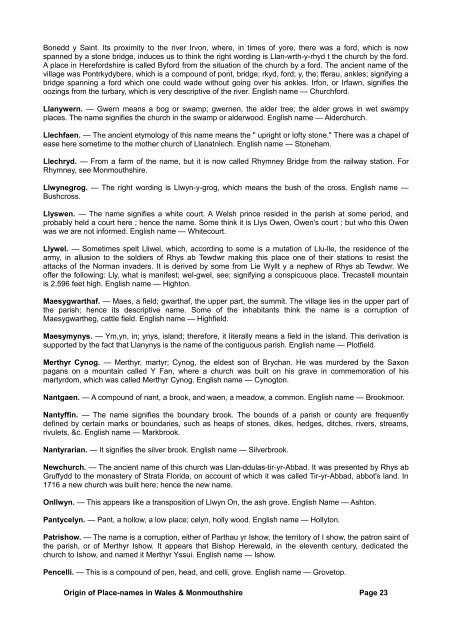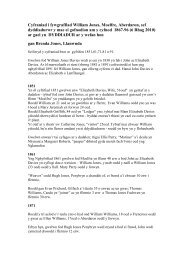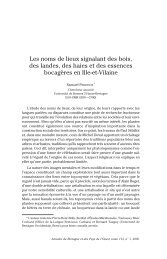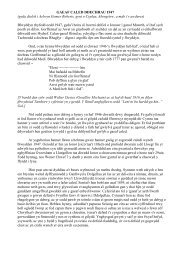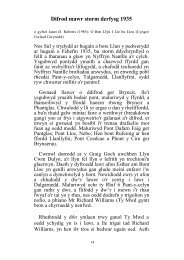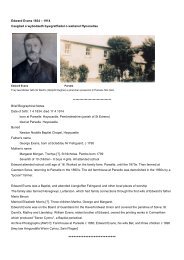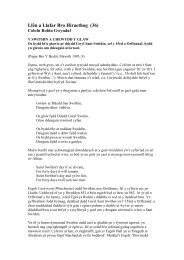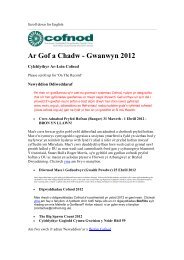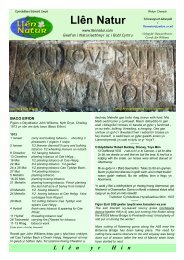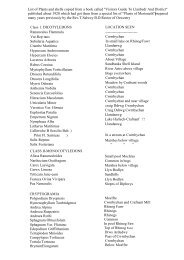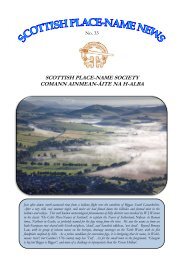Bonedd y Sa<strong>in</strong>t. Its proximity to <strong>the</strong> river Irvon, where, <strong>in</strong> times <strong>of</strong> yore, <strong>the</strong>re was a ford, which is nowspanned by a stone bridge, <strong>in</strong>duces us to th<strong>in</strong>k <strong>the</strong> right word<strong>in</strong>g is Llan-wrth-y-rhyd t <strong>the</strong> church by <strong>the</strong> ford.A <strong>place</strong> <strong>in</strong> Herefordshire is called Byford from <strong>the</strong> situation <strong>of</strong> <strong>the</strong> church by a ford. The ancient name <strong>of</strong> <strong>the</strong>village was Pontrkydybere, which is a compound <strong>of</strong> pont, bridge; rkyd, ford; y, <strong>the</strong>; fferau, ankles; signify<strong>in</strong>g abridge spann<strong>in</strong>g a ford which one could wade without go<strong>in</strong>g over his ankles. Irfon, or Irfawn, signifies <strong>the</strong>ooz<strong>in</strong>gs from <strong>the</strong> turbary, which is very descriptive <strong>of</strong> <strong>the</strong> river. English name — Churchford.Llanywern. — Gwern means a bog or swamp; gwernen, <strong>the</strong> alder tree; <strong>the</strong> alder grows <strong>in</strong> wet swampy<strong>place</strong>s. The name signifies <strong>the</strong> church <strong>in</strong> <strong>the</strong> swamp or alderwood. English name — Alderchurch.Llechfaen. — The ancient etymology <strong>of</strong> this name means <strong>the</strong> " upright or l<strong>of</strong>ty stone." There was a chapel <strong>of</strong>ease here sometime to <strong>the</strong> mo<strong>the</strong>r church <strong>of</strong> Llanatnlech. English name — Stoneham.Llechryd. — From a farm <strong>of</strong> <strong>the</strong> name, but it is now called Rhymney Bridge from <strong>the</strong> railway station. ForRhymney, see Monmouthshire.Llwynegrog. — The right word<strong>in</strong>g is Llwyn-y-grog, which means <strong>the</strong> bush <strong>of</strong> <strong>the</strong> cross. English name —Bushcross.Llyswen. — The name signifies a white court. A Welsh pr<strong>in</strong>ce resided <strong>in</strong> <strong>the</strong> parish at some period, <strong>and</strong>probably held a court here ; hence <strong>the</strong> name. Some th<strong>in</strong>k it is Llys Owen, Owen's court ; but who this Owenwas we are not <strong>in</strong>formed. English name — Whitecourt.Llywel. — Sometimes spelt Lliwel, which, accord<strong>in</strong>g to some is a mutation <strong>of</strong> Llu-lle, <strong>the</strong> residence <strong>of</strong> <strong>the</strong>army, <strong>in</strong> allusion to <strong>the</strong> soldiers <strong>of</strong> Rhys ab Tewdwr mak<strong>in</strong>g this <strong>place</strong> one <strong>of</strong> <strong>the</strong>ir stations to resist <strong>the</strong>attacks <strong>of</strong> <strong>the</strong> Norman <strong>in</strong>vaders. It is derived by some from Lie Wyllt y a nephew <strong>of</strong> Rhys ab Tewdwr. We<strong>of</strong>fer <strong>the</strong> follow<strong>in</strong>g: Lly, what is manifest; wel-gwel, see; signify<strong>in</strong>g a conspicuous <strong>place</strong>. Trecastell mounta<strong>in</strong>is 2,596 feet high. English name — Highton.Maesygwarthaf. — Maes, a field; gwarthaf, <strong>the</strong> upper part, <strong>the</strong> summit. The village lies <strong>in</strong> <strong>the</strong> upper part <strong>of</strong><strong>the</strong> parish; hence its descriptive name. Some <strong>of</strong> <strong>the</strong> <strong>in</strong>habitants th<strong>in</strong>k <strong>the</strong> name is a corruption <strong>of</strong>Maesygwar<strong>the</strong>g, cattle field. English name — Highfield.Maesymynys. — Ym,yn, <strong>in</strong>; ynys, isl<strong>and</strong>; <strong>the</strong>refore, it literally means a field <strong>in</strong> <strong>the</strong> isl<strong>and</strong>. This derivation issupported by <strong>the</strong> fact that Llanynys is <strong>the</strong> name <strong>of</strong> <strong>the</strong> contiguous parish. English name — Plotfield.Merthyr Cynog. — Merthyr, martyr; Cynog, <strong>the</strong> eldest son <strong>of</strong> Brychan. He was murdered by <strong>the</strong> Saxonpagans on a mounta<strong>in</strong> called Y Fan, where a church was built on his grave <strong>in</strong> commemoration <strong>of</strong> hismartyrdom, which was called Merthyr Cynog. English name — Cynogton.Nantgaen. — A compound <strong>of</strong> nant, a brook, <strong>and</strong> waen, a meadow, a common. English name — Brookmoor.Nantyff<strong>in</strong>. — The name signifies <strong>the</strong> boundary brook. The bounds <strong>of</strong> a parish or county are frequentlydef<strong>in</strong>ed by certa<strong>in</strong> marks or boundaries, such as heaps <strong>of</strong> stones, dikes, hedges, ditches, rivers, streams,rivulets, &c. English name — Markbrook.Nantyrarian. — It signifies <strong>the</strong> silver brook. English name — Silverbrook.Newchurch. — The ancient name <strong>of</strong> this church was Llan-ddulas-tir-yr-Abbad. It was presented by Rhys abGruffydd to <strong>the</strong> monastery <strong>of</strong> Strata Florida, on account <strong>of</strong> which it was called Tir-yr-Abbad, abbot's l<strong>and</strong>. In1716 a new church was built here; hence <strong>the</strong> new name.Onllwyn. — This appears like a transposition <strong>of</strong> Llwyn On, <strong>the</strong> ash grove. English Name — Ashton.Pantycelyn. — Pant, a hollow, a low <strong>place</strong>; celyn, holly wood. English name — Hollyton.Patrishow. — The name is a corruption, ei<strong>the</strong>r <strong>of</strong> Parthau yr Ishow, <strong>the</strong> territory <strong>of</strong> I show, <strong>the</strong> patron sa<strong>in</strong>t <strong>of</strong><strong>the</strong> parish, or <strong>of</strong> Merthyr Ishow. It appears that Bishop Herewald, <strong>in</strong> <strong>the</strong> eleventh century, dedicated <strong>the</strong>church to Ishow, <strong>and</strong> named it Merthyr Yssui. English name — Ishow.Pencelli. — This is a compound <strong>of</strong> pen, head, <strong>and</strong> celli, grove. English name — Grovetop.Orig<strong>in</strong> <strong>of</strong> Place-<strong>names</strong> <strong>in</strong> Wales & Monmouthshire Page 23
Penderyn. — A corruption probably <strong>of</strong> Penydaren, which is a very frequent term <strong>in</strong> South Wales, signify<strong>in</strong>g arocky cliff, a rocky tump. The church is situated on <strong>the</strong> very summit <strong>of</strong> a rock. Pen-mailard is close by, whichis a corruption <strong>of</strong> Pen-moel-arth, <strong>the</strong> summit <strong>of</strong> <strong>the</strong> bare cliff. English name — Cliff by.Pentrefel<strong>in</strong>. — Pentre, village; fel<strong>in</strong>, mill. English name — Millham.Pentre Solers. — From <strong>the</strong> Solers or de Solariis, Norman conquerors, who settled <strong>in</strong> <strong>the</strong> neighbourhood,<strong>and</strong> cont<strong>in</strong>ued to be very wealthy <strong>and</strong> <strong>in</strong>fluential here until <strong>the</strong> middle <strong>of</strong> <strong>the</strong> seventeenth century. Ano<strong>the</strong>rbranch <strong>of</strong> <strong>the</strong> house <strong>of</strong> Solers settled at Pauntley <strong>and</strong> Shipton Solers, <strong>in</strong> Gloucestershire. English name—Solerston.Pontbrenllwyd. — Pont, bridge; pren, wood; Uwydy grey, adorable. In olden times a very ancient oak-treewas thrown across <strong>the</strong> rivulet <strong>in</strong> <strong>the</strong> <strong>place</strong>, which was a very good specimen <strong>of</strong> <strong>the</strong> unadorned woodenbridges <strong>of</strong> our forefa<strong>the</strong>rs. In course <strong>of</strong> time this old much-worn oak became a k<strong>in</strong>d <strong>of</strong> a trough, for which itwas called Pontbrenllwyd. English name— Woodbridge.Pontneddfechan. — Nedd fechan, <strong>the</strong> lesser Neath, is a tributary empty<strong>in</strong>g itself <strong>in</strong>to <strong>the</strong> greater Neathriver, <strong>and</strong> spanned by a bridge <strong>in</strong> <strong>the</strong> village, hence <strong>the</strong> name. English name — Neath Bridge.Pontsarn. — Sam, Roman paved road. The common op<strong>in</strong>ion is that <strong>the</strong> Romans constructed a road fromMerthyr Tydfil over <strong>the</strong> site <strong>of</strong> <strong>the</strong> present Cyfarthfa Park to <strong>the</strong> <strong>place</strong> now called Pontsarn. English name —Bridge-road.Pontsenny. — The name signifies a bridge across <strong>the</strong> Senny river. Senny is derived by some from san, afishery, nets; <strong>and</strong> gwy, water; signify<strong>in</strong>g a river abound<strong>in</strong>g <strong>in</strong> fishes. Mr. Jones (" History <strong>of</strong> Brecknock ")derives it from <strong>the</strong> Celtic seanaidd, to drop or ooze forth, <strong>the</strong> name, accord<strong>in</strong>gly, signify<strong>in</strong>g <strong>the</strong> ooz<strong>in</strong>g orflow<strong>in</strong>g water. It might be a corruption <strong>of</strong> swn-wy, <strong>the</strong> noisy water. English name — D<strong>in</strong>water Bridge.Pontsticyll. — A compound <strong>of</strong> pont, bridge; <strong>and</strong> ystigl, a stile, from <strong>the</strong> Anglo-Saxon stigel, a step. Stigan, toascend. About <strong>the</strong> beg<strong>in</strong>n<strong>in</strong>g <strong>of</strong> this century <strong>the</strong>re was an old bridge, a little below <strong>the</strong> village, with a stile ateach end <strong>of</strong> it, from which <strong>the</strong> <strong>place</strong> received its name. English name — Bridgestile.Pr<strong>in</strong>cetown. — From an old public house <strong>in</strong> <strong>the</strong> <strong>place</strong> called " Pr<strong>in</strong>ce <strong>of</strong> Wales."Pwllgwrach. — Pwll, a pool; gwrach, a hag; literally, <strong>the</strong> hag's pool. The village lies <strong>in</strong> a deep valley at <strong>the</strong>base <strong>of</strong> Talgarth Hill. English name — Hag's Pool.Rhosferrig. — Rhos, moor, meadow; Ferrig from Ferreg, an extensive district situate between <strong>the</strong> riversWye <strong>and</strong> Severn. The suffix is probably a corruption <strong>of</strong> Meurig. English name — Moorton.Seven Sisters. — Mr. Bevan, when he opened his colliery <strong>in</strong> <strong>the</strong> <strong>place</strong>, called it Seven Sisters <strong>in</strong> honour <strong>of</strong>his seven daughters.Tafarnau Bach. — The ancient name <strong>of</strong> this <strong>place</strong> was Twyn-aber-dwynant, a hillock where two brooksembrace each o<strong>the</strong>r. Some derive <strong>the</strong> present name from tafarn a bach, a public house with a hook attachedto <strong>the</strong> outer wall, whereto <strong>the</strong> rider, hav<strong>in</strong>g dismounted his steed, could fasten it. O<strong>the</strong>rs derive it from <strong>the</strong>great number <strong>of</strong> small taverns <strong>in</strong> <strong>the</strong> <strong>place</strong>. English name — Tavernton.Talachddu. — Achddu is <strong>the</strong> name <strong>of</strong> a small brook. Ach, a stem, a pedigree, a river; ddu, <strong>in</strong>flection <strong>of</strong> du,black. We f<strong>in</strong>d ach <strong>in</strong> Clydach, Mawddach, &c. The river Ach has its source <strong>in</strong> <strong>the</strong> Black Mounta<strong>in</strong>; hence it iscalled Achddu. English name- Blackbrook.Talgarth. — Garth mear denotes <strong>the</strong> end or head <strong>of</strong> hill. English name — BrowhTalybont. — Tal, when applied to bont means end; but when applied to Talies<strong>in</strong> means radiant front c ???<strong>and</strong> means Bridgend.Talyllyn. — Llyn, lake. The name signifies <strong>the</strong> end <strong>of</strong> a lake. Safaddan Lake is close by. English name —Lake's End.Orig<strong>in</strong> <strong>of</strong> Place-<strong>names</strong> <strong>in</strong> Wales & Monmouthshire Page 24
- Page 1 and 2: HANDBOOK OF THE ORIGIN OF PLACE-NAM
- Page 3 and 4: § § § § §The Author begs to st
- Page 5 and 6: pitiful cries of the railway offici
- Page 7 and 8: Bishop Percy says that "in England,
- Page 9 and 10: The city of Chester is still popula
- Page 11 and 12: There's Cumwhitton, Cumwhinton, Cum
- Page 13 and 14: Llwyn in its primary' sense means a
- Page 15 and 16: PLACE-NAMES IN WALES.Wales. — The
- Page 17 and 18: Church are generally dedicated to e
- Page 19 and 20: think he was a contemporary of St.
- Page 21 and 22: Rhosbeirio. — Rhos, a moor, a dry
- Page 23 and 24: of Brecknock," states that this vic
- Page 25: Cam cnwir ef Cwmdu,Cwm gwyn yw & n
- Page 29 and 30: Ardudwy. — Ar, upon or above; tud
- Page 31 and 32: to mark its pre-eminence over the o
- Page 33 and 34: Some think that eirw is a corruptio
- Page 35 and 36: present form — Caerfyrddin.Abergw
- Page 37 and 38: place of refuge; hence the name. En
- Page 39 and 40: Llansawyl. — The church was dedic
- Page 41 and 42: eject. The village took its name fr
- Page 43 and 44: house, and attempted to kill an inf
- Page 45 and 46: Gwydir. — Prima facie one may tak
- Page 47 and 48: Nefyn. — The church was probably
- Page 49 and 50: DENBIGHSHIRE.Anglicized form of Din
- Page 51 and 52: Llangollen. — From Collen, a sain
- Page 53 and 54: hands into their pockets to pay a c
- Page 55 and 56: Cefn. — The name signifies a ridg
- Page 57 and 58: Maesgarmon. — Named in honour of
- Page 59 and 60: Abertridwr. — Tridwr, three water
- Page 61 and 62: it is said, was originally built by
- Page 63 and 64: Cwmllynfell. — Cwm, a narrow vale
- Page 65 and 66: Gwarycaeau. — Gwdr, the nape of t
- Page 67 and 68: means a cultivated region, a vale,
- Page 69 and 70: Penrhiwfer.- Pen, head, top; rhiw,
- Page 71 and 72: Port Talbot. — So called in 1835
- Page 73 and 74: Trealaw. — This appellation was g
- Page 75 and 76: Aberdyfi. — So called from its si
- Page 77 and 78:
Llanddwywe. — From Dwywau, a desc
- Page 79 and 80:
Crickhowell and some in the directi
- Page 81 and 82:
Griffithstown. — This village was
- Page 83 and 84:
and gwy, water. Treiddiod troth tna
- Page 85 and 86:
derive Tintern from din, fortified
- Page 87 and 88:
Caersws. — It appears that the Ro
- Page 89 and 90:
English name — Ervylton.Llanymech
- Page 91 and 92:
Angle. — Probably from the angle-
- Page 93 and 94:
Gellyswick. — Another hybrid. Gel
- Page 95 and 96:
that the two rivers in their flowin
- Page 97 and 98:
ecame the bishop of the see, and wa
- Page 99 and 100:
earth formerly stood on a summit on
- Page 101 and 102:
Pilleth. — A corruption of pwll,
- Page 103 and 104:
Howells, Rev. J., Mountain AshHowel
- Page 105 and 106:
Williams, D., PenywernWilliams, Rev


